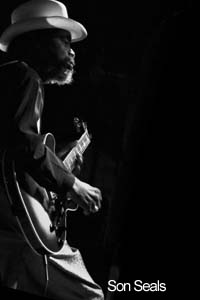The Good Doctor

“Son Seals was a man that everybody loved. I loved him, speaking for myself. And everybody that I know, you know, like the other entertainers and things, if they mentioned Son Seals, it was always something good they had to say.”
– Koko Taylor
Son Seals was my doctor. Whenever I stepped into his “office,” whether it was at Wise Fools Pub, B.L.U.E.S On Halsted, Blues Etc., Kingston Mines, or Albert’s Hall in Toronto I would greet him with a cheerful “Hi Son.” He would take to the stage and masterfully tinker with my mind and my emotions for the next few hours, and when our appointment came to an end I’d inevitably say goodbye to him with a heartfelt “Thanks, Doc!” Son would smile, confident he had healed yet another soul through the depth and intensity of his music.
A Journey Through The Blues: The Son Seals Story (Vizztone) is a documentary about the late legendary guitarist who passed away at age 62 in December, 2004. Produced by Seals’ friend and filmmaker Peter Carlson, A Journey Through The Blues creates a compelling portrait of the artist. Interview footage with Seals is interspersed with that of his sister Kat Sims, son Rodney, Bruce Iglauer of Alligator Records, Koko Taylor, Lonnie Brooks, Steven Seagal, Dr. John, Frank Pellegrino of Kingston Mines, and Bubba Sullivan of King Biscuit Blues Festival. Still photos and performance footage are sprinkled throughout against a soundtrack of 12 songs that include “Bad Axe,” “Osceola Rock,” “Help Me Some-body,” “Funky Bitch,” “Hot Sauce,” “No, No, Baby,” and the poignant “My Life.” Bonus footage includes performances from the Rooster Blues nightclub, Chicago’s House Of Blues, and Son’s last performance at the Chicago Blues Festival.
A Journey Through The Blues is divided into 10 segments or chapters (each captioned by a quote from one of the interviews), and each covers a stage of Seals’ career, from his beginnings in Osceola, Arkansas, where he absorbed the music he heard in his father’s juke joint the Dipsy Doodle, through the development of his musical voice, taking that voice to a worldwide audience, and finally to his tragic last years. Family, close friends, and musical associates act as a Greek chorus, fleshing out the development of his career with anecdotes and insights into his musical drive and personality.
The most interesting and informative segments belong to Seals himself, though. In “Before You Develop You, There Is No You” he talks about finding his musical voice: “You had to start out playing like somebody because before you develop you, there is no you. You had to be able to make everybody happy. That meant you had to be able to play everything on the jukebox from Muddy Waters and Howlin’ Wolf to Sam Cooke, Fats Domino, Little Richard – you name it. You had to play it all.”
He goes on to say that was all well and good, but musically, “Who in the hell is Son Seals?” He worked diligently to create his own sound: “I scuffle with myself . . . until boom, here it come. It sounds all right, it sounds a little different to me, I don’t know, somebody got to tell me.”
According to Koko Taylor, who speaks lovingly of him throughout the documentary, Seals “played his own style. He sounded different; he had a different sound in his guitar. When you heard it, everyday knew it was Son Seals in the that club.”
Seals brought so much to the blues. He played hard with a fierce intensity and was a gifted and original songwriter and arranger who brought a sophisticated, horn-driven sound to the deepest Delta blues. He was an impassioned vocalist with a rough, gritty voice and an innovator, adding a flute solo to Jimmy Reed’s “The Sun Is Shining.” He was a master at building a guitar solo – his sense of dynamics was unmatched among bluesmen. Seals was one of those guitarists who could stand flatfooted on stage and move you with the sheer power of his playing; he mesmerized audiences.
Despite these many talents, Seals was undervalued for much of his career. Like so many bluesmen before him, he was ascending to the next level (guest spots on “Late Night With Conan O’Brien” and musical collaborations with Jimmy Vivino and Phish’s Trey Anastasio) when he died.
My only knock on the documentary is the impression it makes of Seals as a struggling, hard-luck bluesman. He had many difficulties in the last years of his life (his ex-wife shot him in the face while he slept, leaving a bullet permanently implanted in his jaw; his motor home was destroyed by fire while on tour – not mentioned in the documentary; and he lost his leg to diabetes) but we only hear about these hardships from others, not Seals. Through it all he remained focused on his music. In 2001, he told a reporter from Blues Access magazine “Anytime I had a spell of sickness, all I’d want to do is get better so I could get back out there and play. I never thought, ‘God, let me get better, so I can get out there and write the ‘Diabetes Blues’ or the ‘I Lost My Leg Blues.” All I wanted to do is get better, so I could get back to work.”
A Journey Through The Blues is a portrait of a man who was uncompromising in music and life. Son Seals belied blues stereotypes at every turn. When the dialysis treatments became too much for him, according to his sister, he simply stopped taking them, and shortly afterward passed away.
– Beverly Zeldin-Palmer
Category: Columns, Monthly, Sweet Home









